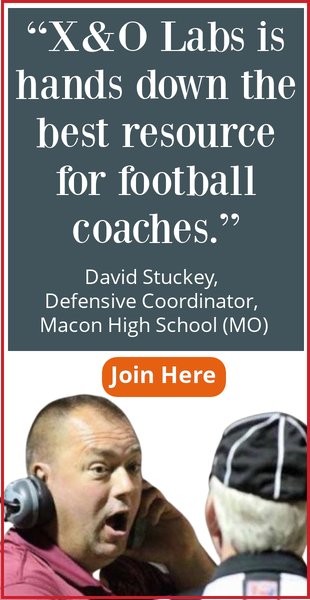By Laban DeLay, Head Coach
Billy Skinner, Safeties
Arlington Lamar High School (TX)
Twitter: @Coach_DeLay & @CoachSkinz
Introduction:
We are in a football era where defending offenses is becoming a more difficult challenge each year. Winning football games 3-0 or 7-6 are few and far between due to athletic ability and the creative minds of offensive coaches. At Lamar High School, we are diligent about not staying in one front or coverage very often and trying to create confusion for the quarterback and offensive coordinator. This clinic report will feature the Lamar Vikings defending empty sets by bringing a variety of pressures and mixing the coverages.
Scheming Empty Formations
Our number one priority as a defensive staff is to be sound against the run in every formation while taking away the opponent’s favorite pass concepts. To do this, we analyze our opponent’s run game from each formation along with their personnel groupings. When we encounter empty formations, we design a 4 to 5 call package tailored to take away their favorite plays and to neutralize their best offensive player. These calls are designed to not only take away their favorite plays, but also to add confusion to their quarterback by a mixture of coverages & fronts. Here are a few examples:
- If we are playing a quarterback who is better in the pocket, we design a man pressure that will move him off of his spot and ultimately throw off his timing in accordance to routes.
- If we are facing an athletic quarterback, who is more prone to scramble, we will design a zone pressure that will allow us to keep “Zone Eyes” on him, while we play games with the coverage in the back end.
- Against a stud receiver, we can design coverage adjustments using our base package to play “STAR” coverage, to eliminate him out of that particular play or series.
We like to mix and match all of these concepts together when we customize our empty package for each opponent every week. During our practice week, we will rep all of our calls while giving our linebackers the freedom to make our empty call checks and our safeties will adjust the coverage to keep everything sound. This allows them to feel ownership in our defense and encourages them to study our game plan thoroughly. We, as coaches, also have the capability to “lock” in a specific coverage per the game situation rather than our allowing our linebackers and safeties to make the adjustments. Our “adjust” call allows the safeties to call a coverage that is best suited vs the formation the offense presents to us. Our safeties have to be great communicators with each other because many times we will make a split coverage call. For example, we might play Cover 2 to one side while playing Cover 4 or perhaps man coverage to the other side. Our safeties will communicate the coverage with one another first & then relay the coverage call to their side corner & outside linebacker. We feel that our “adjust” coverage allows us the flexibility to get into the most favorable coverage as we will detail later in this report.
“Adjust” Coverage vs. Empty
We teach our basic coverage principles in a classroom setting we call “Football 101”. We begin with Cover 2 and illustrate this coverage vs multiple formations. We instruct alignment, strengths, weaknesses as well as proper execution of Cover 2. We proceed to teach each of our coverages in this manner to educate our players on the multitude of looks we can run in the defensive backfield. We want to build comfort level with our players in such that we can run any coverage vs any formation. Through our “Football 101” education we then discuss which coverages we prefer to certain formations and concepts which is a critical part for our safeties with the “Adjust” call. Now that our players have a solid foundation of our coverage schemes, it enables us to mix and match coverages against our opponents. For example, if a team is running empty and runs a vertical scheme to the three receiver side we may want to run our quarter’s concept there, and run our read Cover 2 concept to the two receiver side.
Quarter, Quarter, Half vs. Empty
When we run quarters to the trips side of empty it is imperative that the safety and corner read the route concepts. If the route combination does not threaten our zone then our eyes must move to the next most dangerous threat, thus we never “cover grass”. Corners will be responsible for the outside quarter, so their eyes will go from the #1 receiver (the furthest outside) to #2, and then to the #3. If there is a smash concept (#1 stop, #2 corner route) the corner will stay over the top of the corner route and allow the underneath coverage to be responsible for the stop. The safety is responsible for the inside quarter, so his read must go from the #3 receiver to #2 and then to #1. If he reads that #3 is vertical he pedals for depth and protects his hash. On the quarters side, the key to success is the underneath coverage. The outside backer starts with his eyes in the backfield for his run/pass key. If pass, outside backer must take speed off the #2 receiver with a violent re-route. He is the curl/flat player and we believe that the quarterback’s front shoulder will direct his drop. If the shoulder is quick game or screen now and his hand comes off the ball, we must locate the “quick man” and trigger. If the quarterback’s shoulder and eyes lock vertical, he can carry his re-route deeper. Inside backer’s initial alignment against empty is to discourage the hot of #3 strong and #2 weak. Their main responsibility is to handle the quarterback run scheme that the offense presents. After reading pass, the inside backers will protect the hash allowing nothing to cross the face underneath them while taking away the hot routes. The job of the inside backers is to force the quarterback to attempt the longest and/or widest throw to give time to the secondary players to react and make a play on the ball. The #1 goal of the inside backers is to protect the hash so the safeties are not put in a matchup with more than 2 receivers in their zone.









